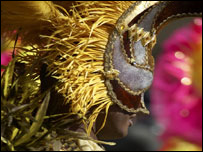Take Away English-Notting Hill Carnival 诺丁汉狂欢节(在线收听)
Party Time 狂欢时刻
|
If you love to party and are crazy about samba dancing , there is only one place to go in August - London . Yes, that's right. London . Every year on the last weekend in August, around 1.5 million people go to west London to take part in and enjoy one of the largest street parties in Europe , Notting Hill Carnival. |
 A reveller at the Notting Hill Carnival |
The roots of the carnival date back to 1833 when slavery was abolished . In that year the former slaves in Trinidad, a British colony in the Caribbean , took to the streets in celebration for their own carnival party with music, dance and costumes .
Over the years, carnival developed into an important tradition throughout the Caribbean, particularly in Trinidad . It was here that the 5 disciplines of carnival were established.
The disciplines consist of mas - this discipline refers to the exotic costumes and beautiful floats ; calypso - t his is a traditional type of music from Trinidad; soca - this is the modern, more energetic form of calypso; steelpan - a traditional musical instrument from Trinidad; sound systems - these consist of DJs who play a wide range of music.
In the 1950s, immigrants from the Caribbean began to arrive in the UK , and they brought with them their music and traditions. In 1959 the first carnival took place in the St Pancras area of London . For the next few years, the Carnival was celebrated in different parts of London until it finally came to Notting Hill in 1964.
Year after year, immigrants from other countries began to participate in the carnival, as did the local British people, and the carnival grew to reach its current enormous proportions. In 2003 the Notting Hill Carnival received royal approval , when it joined the parade to mark the celebrations for the Queen's 50 th year on the throne.
Although it still has a strong Caribbean influence, it now features many types of music from hip hop to house , reggae to salsa . For many people today, the Notting Hill Carnival is not just a wonderful celebration but a manifestation of the cultural diversity of modern London.
|
GLOSSARY 词汇表 |
|
|
|
|
|
|
|
|
|
|
|
|
|
|
|
|
|
|
|
|
|
|
|
|
|
|
|
|